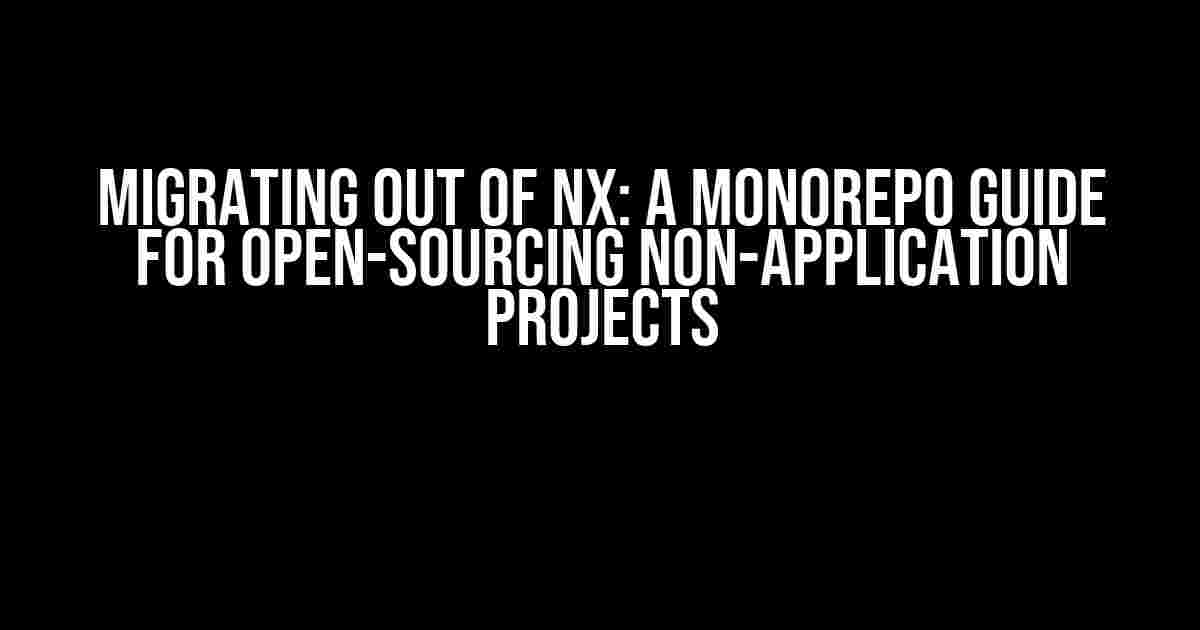Are you part of a development team that’s grown fond of the convenience and scalability of NX monorepos, but now wants to open-source some non-application projects while retaining the same dev experience? You’re in the right place! In this comprehensive guide, we’ll walk you through the process of migrating your non-application projects out of NX, allowing you to share your work with the world while maintaining the same level of productivity and efficiency.
Why Migrate Out of NX?
Before we dive into the migration process, let’s address the elephant in the room: why would you want to leave the comfort of NX? There are several reasons:
- Open-sourcing non-application projects**: If you have libraries, tools, or other non-application projects that you want to share with the open-source community, NX might not be the best fit. By migrating these projects out of NX, you can make them more accessible and maintainable.
- Reduced complexity**: NX monorepos can become complex and overwhelming, especially for smaller projects. By migrating out, you can simplify your project structure and reduce the overhead associated with maintaining a monorepo.
- Greater flexibility**: With a traditional repository structure, you’ll have more freedom to choose your own tools, workflows, and dependencies, allowing you to adapt to changing project needs more easily.
Preparing for Migration
- Identify the projects to migrate**: Determine which non-application projects you want to open-source and migrate out of NX. Make sure they’re self-contained and can function independently.
- Assess dependencies and integrations**: Take stock of any dependencies, integrations, or plugins that your project relies on within the NX monorepo. You’ll need to ensure these are compatible with your new repository structure.
- Update your project’s package.json**: Remove any NX-specific configurations or dependencies from your project’s `package.json` file. This will help you avoid conflicts during the migration process.
Migrating Your Project
Step 1: Create a New Repository
git init
git add .
git commit -m "Initial commit"
git remote add origin <repository-url>
git push -u origin mainStep 2: Move Project Files
git checkout -b migration
git rm -rf <unwanted-files-or-folders>
git commit -m "Remove unwanted files"
git push origin migrationStep 3: Update Configuration Files
// tsconfig.json
{
"compilerOptions": {
// Update the 'rootDir' to point to the new repository root
"rootDir": ".",
// ...
}
}Step 4: Fix Broken Dependencies and Integrations
// package.json
{
"dependencies": {
// Update dependencies to reflect the new repository structure
"@my-company/my-library": "file:../my-library"
}
}Retaining Dev Experience
Use Similar Tools and Workflows
Implement Similar Linting and Formatting Rules
// .eslintrc.json
{
"root": true,
"env": {
"node": true
},
"extends": "eslint:recommended",
"rules": {
"no-console": "error"
}
}Document the Migration Process
| Milestone | Description |
|---|---|
| Identify projects to migrate | Determine which non-application projects to open-source and migrate out of NX. |
| Assess dependencies and integrations | Take stock of dependencies, integrations, and plugins that need to be updated or replaced. |
| Migrate project files | Move project files from the NX monorepo to the new repository. |
| Update configuration files | Update configuration files to reflect the new repository structure. |
| Fix broken dependencies and integrations | Update dependencies, install new dependencies, or reconfigure plugins as needed. |
Conclusion
Migrating out of NX and into a traditional repository structure can be a daunting task, but with careful planning and execution, you can successfully open-source your non-application projects while retaining the dev experience your team loves. Remember to document the process, update your configuration files, and fix broken dependencies to ensure a seamless transition.
Frequently Asked Questions
Get answers to your burning questions about migrating outside NX for open-sourcing non-application projects while retaining dev experience.
Why should I consider migrating outside NX for open-sourcing non-application projects?
Migrating outside NX allows you to open-source non-application projects without exposing your entire monorepo. This ensures that sensitive application code remains private while making your non-application projects available to the wider developer community. Plus, you get to retain the dev experience and benefits of NX for your application projects!
How do I determine which projects to migrate outside NX for open-sourcing?
Identify projects that are decoupled from your application code and have potential value to the broader developer community. Consider projects that are utility libraries, plugins, or tools that can be used by others. This will help you prioritize which projects to migrate first and ensure a smooth transition.
Will I lose the benefits of NX after migrating projects outside for open-sourcing?
Absolutely not! You can still utilize NX for your application projects and retain the benefits of monorepo management, such as easy dependency management and consistent builds. For open-sourced projects, you can use alternative tools and workflows that are better suited for community-driven development.
How do I maintain consistency between my NX-based application projects and open-sourced projects?
Establish clear guidelines and coding standards for both your NX-based application projects and open-sourced projects. This ensures consistency in coding practices, naming conventions, and documentation. You can also leverage CI/CD pipelines to automate testing and deployment processes, maintaining a unified development experience across both environments.
What’s the best approach for managing dependencies between Nx-based projects and open-sourced projects?
Use a hybrid approach that combines the strengths of monorepo management with open-source project management. For dependencies between NX-based projects, utilize Nx’s built-in features for managing dependencies. For open-sourced projects, use package managers like npm or yarn to manage dependencies. This hybrid approach ensures seamless integration and reduces complexity.


